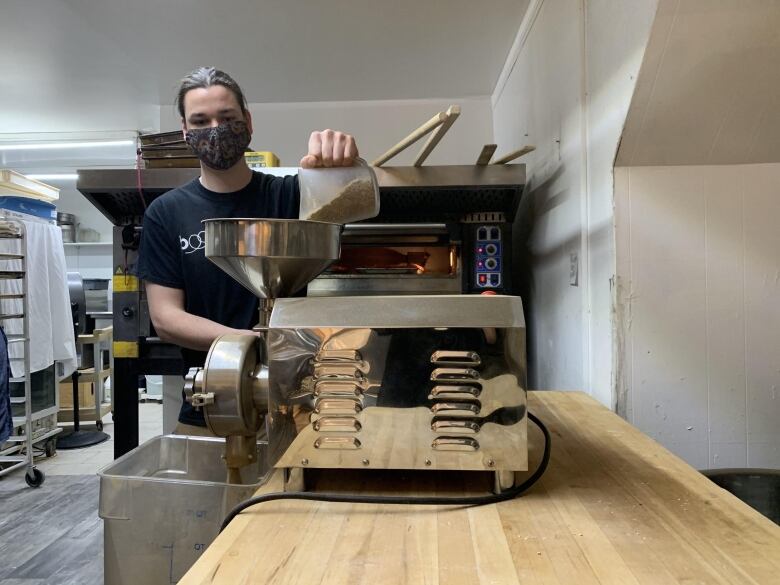How upcycling turns industrial food leftovers into certified tasty meals
Similar to practice with organic products, upcycled food can now be certified

When staff at Guelph's Wellington Brewery has finished making beer, they don't just throw away the spent grain. In fact, you can follow the used materials on a short tour of southwestern Ontario that sees the brewing byproduct travel to Cambridge and Fergus before heading back to Guelph and eventually ontomenus at the Neighbourhood Group of Restaurants.
Using already-used ingredients to create a new food product is the latest iteration of "upcycling" a word that typically refers to transforming clothing orfurniture.
"The easiest way to think about upcycling is thinking about what's left over when a food product has been manufactured or processed. A simple example is when you make beer. There is spent grain left over, but that has an incredible amount of nutrients and value left," saidCher Mereweather, CEO of Guelph's Anthesis Provision,a food and beverage sustainability company, who facilitated the Wellington spent-grain upcyclenetwork.
And beyond grain, onion trimmingsfrom onion-ring production can be used to make broths;the byproducts of tofumakingcan be used to createramen noodles;and discarded peas can be used to make plant-based protein powder.
Wellington Brewery's spent grains go to feed cultivated insects at Oreka Solutions, near Cambridge. Oreka's insects, in turn, become livestock and chicken feed and nutrition for the trout at Izumi Aquaculture in Cambridge. The trout then head to Guelph's Neighbourhood Group restaurants (Wooly, Borealis, Miijidaa) for fish dishes.
But it doesn't stop there:detritus from Izumi'sfish productionareas goto Fergus to become fertilizer for Smoyd Farm potatoes; Smoyd potatoes also go to the Neighbourhood Group where they are made into French fries... to accompany the trout dish.
And there's more upcycling: the spent brewing grains also go to Guelph's Grain Revolution bakery and, with the help of yeast from Escarpment Labs, also in Guelph, become spent-grain sourdough.

Upcycling food is gaining traction, according to Mereweather.
With its funders, including OMAFRAand other partners, Anthesis operates the Re(Purpose) Incubator on behalf of the City of Guelph.
Half of Canada's food supply wasted
Upcycling is in its infancy but is growing fast. A few years ago, Outcast Foods started upcycling"ugly" produce that was aesthetically imperfect or otherwise unsuitable for the grocery store. Partnering with grocers and farmers, along with food manufacturers, the company converts the unwanted produce into protein powders, dietary supplements and other plant-based ingredients. You can find the company's protein powders at Sobeys.
Based in Nova Scotia, Outcast received $1.5 million in federal funding in February to help build a 46,000 sq.-ft. facility in Burlington, Ont. It represents recent efforts among food manufacturers to capture an untapped market for discarded but usefulfood, and thereby reduce food waste.
According to Agriculture and Agri-Food Canada, more than half of Canada's food supply is wasted each year. It estimates $50 billion of that wasted food is avoidable.
And like organic food, now upcycled foods in Canada can now be "Upcycled Certified" by the Upcycled Food Association,an American organization that has just announced its launch in Canada: it's an important recent development, according to Mereweather.
For consumers, certification raises awareness about upcycling, but it also builds confidence in the upcycled food, beverage, cosmetics, pet food, home care, and cleaning products that they can buy. Mereweather says the certification helps deal with the false impression that upcycled food is somehow substandard or "bad."
"There's this misconception that we're using waste, but it's not waste. It's the unavoidable by-products that happen when we make something, and it can be turned into something else," she says.

Their incubator helps businesses identify so-called waste and look for new revenue streams for it. Theincubator assists with defining a new product, creating a value cycle and helping the process of nutrition profiles, food safety, market viability and getting the upcycled product on the shelf or online, she said.
There are a growing number of upcycled products, according to Mereweather, which can be purchased online, if not yet in stores.
Although the company did not go through the Incubator, Mereweather points out that Greenhouse Juice Co. in Toronto uses "seconds" of vegetables and fruits to make their juice and then uses the leftover fibres in pizza crusts.
Abokichi, a company in North York, is a member of the Upcycled Food Association. They make a miso soup with sake lees (the leftover pulp). They say in 2020 they divertedmore than two tonnes of byproduct from becoming food waste.
It's all about changingthe conventional process of food production, Mereweather says, into one thateliminates waste and shares economic prosperity across the value chain and with consumers.
"Our food system right now is built on a linear model. We take resources, we make something, and then we dispose of [leftover parts]. Upcycling is a circular model, one that's inspired by the planet's natural cycles and one that re-imagines and re-generates the systems that are feeding us."













_(720p).jpg)


 OFFICIAL HD MUSIC VIDEO.jpg)
.jpg)



























































































